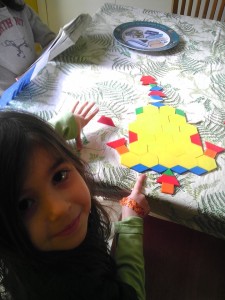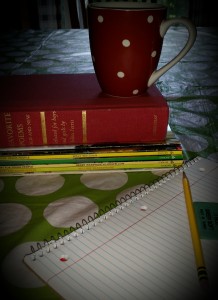A Literature-Based Education: Teaching Academics
August 27, 2014
 This is part 3 of the Literature-Based Education series. Follow these links to read Part 1 and Part 2.
This is part 3 of the Literature-Based Education series. Follow these links to read Part 1 and Part 2.
It may sound obvious enough, but any school subject can be taught through living books. Science, history, art, grammar, even math can be taught with literature! Most homeschoolers are familiar enough with livening up their history and science lessons with living books, as living books can breathe life into any subject!
One of the things I instituted many years ago in our homeschool is Fun Math Fridays. Every Friday we skip our usual math lessons and we play a game or read a living book – I usually let the children choose. There are many quality math stories that can help you teach specific concepts. Too often, math is seen as a boring and difficult subject that can only be taught with dry textbooks. But math is a natural entity that we use all of the time. So why not make it more interesting with living books? This is called Living Math – which is appropriate, since math is everywhere. It’s a living, breathing subject!
 Two of my favorite series of math books are the Mathstart Series
Two of my favorite series of math books are the Mathstart Series and the Sir Cumference series
. Both are colorful picture books that each cover a specific math topic, from fractions to addition to percentages. Greg Tang
and Mitsumasa Anno
have written many fantastic living math books as well. For older children, you can’t go wrong with Marilyn Burn’s books like Math for Smarty Pants
and The I Hate Mathematics! Book.
Some ideas for a Fun Math Friday to get you started:
- Math manipulatives – pattern blocks, tangrams, counting bears, dominoes or dice
- Games – monopoly, Smath, card games like War, Uno or Rummy, dice games like Yahtzee
- Cooking – double or triple a batch of cookies and let your child figure out the recipe
- Look for patterns in nature on a nature walk
- Read a living book and then explore the topic more thoroughly with manipulatives
- Play with numbers outdoors with sidewalk chalk
- Explore with different kinds of calculators
- Play with a hundred’s chart and discover all the different patterns
- Have fun with rulers, yard sticks and measuring tape – measure everything!
There are so many ways to play with math – it never has to be a dull subject.
History and science are the easiest to implement in a literature based curriculum. There are thousands of living books to choose from to round out your studies! Choose a solid spine book like The Story of the World, A History of US: Eleven-Volume Set: Paperback Set
or the The Story of Science
series and then fill in literature to round it out. I love historical fiction, but one can easily get carried away – there is just so much of it.
While some stories are true to history, like Johnny Tremain, Fever 1793
, Girl in a Cage
and such, you need to be careful with inaccurate historical fiction. When well written, they could potentially lead to a research project to determine the truth. But these works can just cause confusion, especially with younger children. One of the benefits to using a curriculum like Build Your Library, is that the books have already been vetted.
There are also different points of view about how to study history – do you want to go chronologically or hop around by interest? Four year cycle? Six year cycle? There are so many different ways to go about it. I prefer to do a 4 year cycle in elementary school, take a break in the middle grades to cover American History and World Geography, and then come back to the 4 year cycle in high school.
But in the end, as long as you provide your child with the tools to learn on their own – teach them to read well, to express themselves, and to find the answers to their questions – they’ll be able to make up for any gaps in their learning later on. Missing out on learning about the Crusades or the Tudors won’t harm their ability to get into a good college or their ability to function as a successful adult. 😉
I’m a big believer in providing children with a banquet. Instead of just reading nothing but history texts and historical fiction, I like to include literature in their studies – classic works like The Complete Tales of Winnie-the-Pooh, Alice’s Adventures in Wonderland
, and Charlotte’s Web
, and more modern reads like Harry Potter
and The Tale of Despereaux
. Providing a variety of genres helps to expose children to all the different ways of telling a story. Maybe they’ll discover a genre they never even knew existed!
And don’t forget poetry, folk/fairy tales, and mythology! Poetry can feel daunting, but it really isn’t. Choose a quality book (I really love the Poetry for Young People series, but there are so many really nice poetry anthologies out there today) and just read a few poems over breakfast once or twice a week. When you’re just starting out, don’t worry about getting too involved – just read the poems. Later you can study one poet at a time, really getting an ear for their style. Maybe give them the opportunity to play around with poetry of their own. I like the magnetic poetry you can just stick on the refrigerator – take turns throughout the day arranging the words to create a thrilling or silly poem. Learn about the rules for Haiku and Sonnets and then write your own. Just enjoy the act of playing with words.
 And don’t discount fairy tales and mythology – they make up a huge amount of cultural literacy! I love the Albert Einstein quote that says:“If you want your children to be intelligent, read them fairy tales. If you want them to be more intelligent, read them more fairy tales.” I would argue that the same goes for mythology. By exposing your child to these ancient tales, you are guiding them into a common language. Suddenly all those Disney movies make sense – they are nearly all based on fairy tales and mythology! But more than that, they teach your child about story structure, lessons in morality, critical thinking skills, and more.
And don’t discount fairy tales and mythology – they make up a huge amount of cultural literacy! I love the Albert Einstein quote that says:“If you want your children to be intelligent, read them fairy tales. If you want them to be more intelligent, read them more fairy tales.” I would argue that the same goes for mythology. By exposing your child to these ancient tales, you are guiding them into a common language. Suddenly all those Disney movies make sense – they are nearly all based on fairy tales and mythology! But more than that, they teach your child about story structure, lessons in morality, critical thinking skills, and more.
I also love going off tangent with my kids in order to follow their interests. I like to be flexible enough to dive down a rabbit trail or even a whole unit study when the need arises. Just because we’re studying Ancient history doesn’t mean we can’t explore a different time period if my child is interested right now.
An example of following a rabbit trail: A few years ago, my children were fascinated by the Titanic. I don’t even remember exactly how it started – I think one of the twins, at random, chose a book about it at the library. This of course, led to quite a few questions. So we found a few more books to read, talked about icebergs and buoyancy, ship building, famous people that were on the Titanic, we watched parts of the movie as well as a few other documentaries, and my oldest even wrote a short historical fiction book that took place on the Titanic about a little girl who was sailing on the ship with her mother. All of this was organic – they asked questions and we dug in and researched and learned. When they were done, we went back to the lesson plans.
Studying science can look the same way. Choose a spine based on the topic you want to study – there are so many fantastic science encyclopedias on the market today that can serve nicely as a spine – then just round out your study with biographies about scientists, picture books, and even novels pertaining to the subject matter. Throw in some meaningful experiments (there are many fabulous kits out there) and you have a solid science program.
When it comes to language arts, living books are the most natural way to learn. Narration is the basis for composition and literary analysis. Copywork and dictation can be used to teach everything from punctuation and mechanics as well as parts of speech and spelling. You can study vocabulary in context right as you are reading beautiful literature aloud to your children. This is really all you need to give your children a thorough grounding in language arts skills.
Educating with literature can be as structured or unstructured as you wish. It can be completely interest led or completely planned out for the entire school year. It can work with a 4 year old just as beautifully as it can work for a high school senior. You’ll not only study a huge variety of material from writers who actually care about their subject matter, you’ll also expose your children to the great conversation, to ideas beyond their own small world, to fantasy worlds filled with magic, to the fascinating world that can only be seen under a microscope. It’s all out there, just waiting to be discovered inside of a good book.
Related Article(s):
- A Literature-Based Education: Teaching Academics
- A Literature-Based Education: Reading Aloud – Making it Happen
- A Literature-Based Education: Choosing Great Literature
- Literature-Based Learning: Creating a Rhythm to your Days
See Also:
A Literary Education: Adapting Charlotte Mason for Modern Secular Homeschooling (Paperback)
 Emily Cook is the author and creator of the secular homeschool curriculum Build Your Library, a literature-based K-12 program infused with the teachings of Charlotte Mason. She writes full year lesson plans as well as shorter topical unit studies. Emily has been homeschooling her four children in Southern NH for 21 years. She is passionate about reading aloud to children of all ages and loves to share her love of literature with others. She and her family also makes incredibly dorky videos about homeschooling, books and more on Youtube at ARRRGH! Schooling. You can follow her on Facebook, Twitter and Pinterest.
Emily Cook is the author and creator of the secular homeschool curriculum Build Your Library, a literature-based K-12 program infused with the teachings of Charlotte Mason. She writes full year lesson plans as well as shorter topical unit studies. Emily has been homeschooling her four children in Southern NH for 21 years. She is passionate about reading aloud to children of all ages and loves to share her love of literature with others. She and her family also makes incredibly dorky videos about homeschooling, books and more on Youtube at ARRRGH! Schooling. You can follow her on Facebook, Twitter and Pinterest.